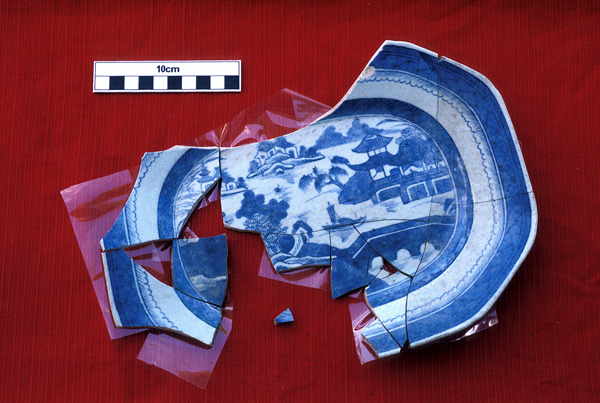
Ceramic plate repair. Photo: Jon Carpenter courtesy of Western Australian Museum.
The conservation of ceramic and glass includes both functional and decorative objects such as jewellery, sculptures, tiles, mirrors, dolls, and chandeliers.
The term ceramics encompasses any type of object that is made out of clay minerals, and can either be fired or un-fired clay. Ceramics are categorised by body type.
In general, ceramics fired at high temperatures have a hard, glassy surface and a securely attached glaze, while low-fired ceramics will have soft, porous surfaces and are prone to poorly attached flaking glazes.
Glass is made from a mixture of ground silica, alkali and calcium, which are then melted together to create molten glass. A variety of forms are created by using different methods, including moulding, slumping and blowing, which are left to slowly cool and harden.
Causes of deterioration
Ceramics and glass are both man-made materials. Thus poor manufacturing methods and material composition can contribute to the deterioration of the clay or glass body.
Glass
Inaccurate proportions of silica, fluxes and stabilizers can weaken glass and make it prone to various kinds of deterioration including exfoliation, pitting, spalling and iridescence.
Weeping can occur when the surface layer of glass to become cloudy and disintegrated and is caused when water vapour in the atmosphere leaches some of the components from the glass.
Crizzling is characterised by very fine fractures on the surface that to begin with may be un-identifiable to the naked eye and can result in the glass becoming recognisably cracked and cloudy with fragments peeling away from the surface. Both are particular common in pre-18th century glass.
Deterioration of glass is most commonly attributed to water. If an object has been in an environment with high water content for a long period of time, or one with high acidic or alkali levels, or has held liquids for extended periods, deterioration in the following forms may occur.
Ceramics
Glazes are particularly prone to problems when firing and can develop microscopic fractures that can cause breakage problems later, or else the glaze shrinks unevenly causing peeling, shivering or scaling of the glaze.
Soluble salts are one of the most damaging forms of deterioration affecting porous ceramic objects. Archaeological objects buried in salty or alkaline soil, submersed in seawater or used to hold salty materials soak up soluble salts. These salts dissolve and re-crystallize as the humidity fluctuates from high to low causing the ceramic structure to be crushed and glazes can flake off and surfaces spall.
Careless or uninformed cleaning of food stains, grease and dirt can cause physical deterioration of ceramic and glass pieces.
Improper handling, shipping, storing or displaying, and the accidental cracks and breakages caused by these, are one of the major sources of deterioration of ceramics and glass.
Treatments
Conservators are trained to assess the ceramic and glass objects, identify areas of concern and evaluate the best course of protection.
Conservators can consolidate surfaces by adding material to replace losses and stabilise and conserve the glass, and/or the glaze.
Conservators can remove soluble salts in ceramics through repeated rinses so that the salt content of the ceramic object is equalised or can provide specific advice on suitable environmental conditions if the object is too fragile to be worked on.
Removal of insoluble salts is best done by mechanical means though chemical treatments are sometimes undertaken.
Complex cleaning methods using acids to remove metal stains or concretions or the use of alkalis for grease and wax removal are undertaken by conservators, as is the repair or infilling of cracks, breaks and loss of glazes using modern conservation grade adhesives or epoxy resins.
Old and brittle glues can be dissolved using appropriate solvents and replaced with more stable alternatives. Staining from metal rivet corrosion (used to repair breaks in the past) can be cleaned while leaving the rivets in place. This is especially important with historic objects as the riveting is considered significant to the history of the object and if professionally done are usually a successful method of stabilising the object.
Conservators can apply surface protectors and advise on how to stabilise environmental conditions that exacerbate deterioration, and suggest best practice for handling, storage and display.
The AICCM Objects Special Interest Group is for those interested in the conservation of objects, including ceramics and glass. Join this group, contribute to its activities, or speak to a specialist conservator.
Need a conservator? Find one here.
Resources
- Ceramics and Glass (International Conservation Services)
- Ceramics and Glass care information (The Canada Conservation Institute)
- Ceramics and Glass objects (American Institute for Conservation of Historic and Artistic works) [PDF – 227KB]